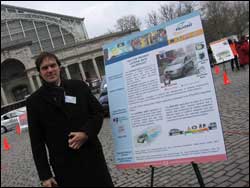Research on the road to intelligent cars

Maxime Flament, Ertico Credit: Terry Brisco
Although safety is improving on European roads, every year over 40,000 people die on Europe’s roads and 1.4 million accidents occur. Clearly, there is still plenty of work to be done if the EU is to halve road fatalities to under 25 000 by 2010, a target fixed in September 2001.
Although intelligent ICT-based systems already exist, their market take-up has been very slow. Reasons for this include legal and institutional barriers, competition among car-makers, the relatively high cost of intelligent systems, lack of customer demand, and above all a general lack of information on and awareness of the potential benefits of such systems.
Partly to counter this, the PReVENT integrated project is devoting 55 million euro to the safety of drivers, passengers and pedestrians. Including over 50 partners, it is made up of sub-projects covering specific road traffic and accident situations.
“What we have are car-safety systems that can support the driver in critical situations,” says Maxime Flament PReVENT manager from ERTICO. In essence, the preventive safety applications help a driver to avoid or mitigate accidents by sensing the nature and significance of the danger, while taking into account the driver’s own state. But this technology must not take control away from drivers, which would restrict user-acceptance.
Take for instance, the MAPS&ADAS sub-project that is creating safety-enhanced digital maps for a variety of other applications other than just route guidance. “We use digital maps as a predictive sensor,” says Vincent Blervaque, project coordinator from ERTICO. “They complement other vehicle speed and position sensors such as lasers and video cameras, which have limited range, to extend the driver horizon at least 300 to 500 metres ahead. For example, a driver can be alerted to what is coming after the next road curve or intersection.”
He expects applications developed under this project will be common in cars within five years, adding that there is lots of interest worldwide from car manufacturers. Better map information could also be used to reduce fuel consumption.
INTERSAFE, the biggest PReVENT sub-project, focuses on traffic safety at intersections. The areas where roads meet are especially dangerous for road users, resulting in 35 per cent to 40 per cent of traffic accidents and 70 per cent of all fatal accidents. In Germany alone, intersections account for 350,000 accidents annually.
“We focused on building an intersection driver warning, using advanced sensors, new vehicle localisation algorithms and communication between the vehicle and road infrastructure,” says project coordinator Kay Fürstenberg, Director of Research at Ibeo, a laser sensors specialist. The resulting intersection assistant warns driver of an impending collision or informs them about the situation at the intersection.
The system has been tested on real roads and helps the driver in three main areas: turning left, crossing traffic, and when drivers miss or ignore stop signs or red lights.
“It is a new idea to use sensors in a vehicle or in infrastructure that talks to cars. For instance traffic lights, which are in constant communication with a car’s onboard computer, can transmit extra details about local traffic,” he adds.
The APALACI sub-project has put together pre-crash and collision-mitigation applications. These include systems to prepare a car’s brakes and to pre-tension seat belts when a collision is imminent. Demonstrator cars also feature LATERAL SAFE sub-project with wing mirrors that flash small warning lights when sensors detect a dangerous object in the car’s blind spots. Partner Volvo already produces cars with the first generation of this clever system.
Also notable are rear-view mirrors with warning lights for when the car strays out of its lane or risks a lateral collision. They call on a range of cameras and radars, able to assess objects at a range of distances.
“The challenge for intelligent safety systems is to avoid false alarms, so that users quickly come to trust them,” says Mattias Schulze, PReVENT coordinator from DaimlerChrysler R&T.
Time-to-market is becoming a crucial issue for the kind of car-safety systems being developed under PReVENT; a process that many traffic experts hope will be accelerated by the recent launch of the European Commission’s Intelligent Car Initiative to boost the uptake of such new technologies.
Media Contact
All latest news from the category: Automotive Engineering
Automotive Engineering highlights issues related to automobile manufacturing – including vehicle parts and accessories – and the environmental impact and safety of automotive products, production facilities and manufacturing processes.
innovations-report offers stimulating reports and articles on a variety of topics ranging from automobile fuel cells, hybrid technologies, energy saving vehicles and carbon particle filters to engine and brake technologies, driving safety and assistance systems.
Newest articles

Redefining Cancer Science: Rodents, Humans, and the PD-1 Puzzle
Results of a comprehensive analysis refute assumptions that a key immune checkpoint receptor functions the same in rodents and humans The Discovery of PD-1: A Milestone in Cancer Treatment Since…

Heart Surgery Risks: Low BP Linked to Postoperative Kidney Injury
First large cohort study at the Heart and Diabetes Center NRW awarded – Hilke Jung presents research project at the FoRUM conference of the Ruhr University Bochum A working group…

Microbial Secrets: Boost Plant Growth with the Power of Soil Bacteria
To stay healthy, plants balance the energy they put into growing with the amount they use to defend against harmful bacteria. The mechanisms behind this equilibrium have largely remained mysterious….



